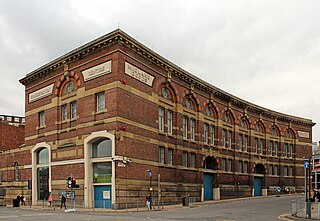
The National Conservation Centre, formerly the Midland Railway Goods Warehouse, is located in Liverpool, Merseyside, England. It stands in a block surrounded by Victoria Street, Crosshall Street, Whitechapel, and Peter Street. After it closed as a warehouse it was converted into a conservation centre for National Museums Liverpool in the 1990s. Initially its exhibition area was open to the public, but this closed in 2010. The centre is recorded in the National Heritage List for England as a designated Grade II listed building.

The Great Northern Warehouse is the former railway goods warehouse of the Great Northern Railway in Manchester city centre, England, which was refurbished into a leisure complex in 1999. The building is at the junction of Deansgate and Peter Street. It was granted Grade II* listed building status in 1974.

Cottonopolis was a 19th-century nickname for Manchester, as it was a metropolis and the centre of the cotton industry.
The Manchester warehouse which we lately visited, was a building fit for the Town Hall of any respectable municipality; a stately, spacious, and tasteful edifice; rich and substantial as its respectable proprietors, the well-known firm of Banneret and Co. There are nearly a hundred such buildings in Manchester; –not so large, perhaps, for this is the largest; but all in their degree worthy of Cottonopolis.
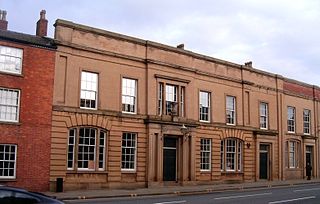
Liverpool Road is a former railway station on the Liverpool and Manchester Railway in Manchester, England; it opened on 15 September 1830. The station was the Manchester terminus of the world's first inter-city passenger railway in which all services were hauled by timetabled steam locomotives. It is the world's oldest surviving terminal railway station. With tracks running at a first floor level behind the building, it could also be considered one of the world's first elevated railway stations.

The architecture of Manchester demonstrates a rich variety of architectural styles. The city is a product of the Industrial Revolution and is known as the first modern, industrial city. Manchester is noted for its warehouses, railway viaducts, cotton mills and canals – remnants of its past when the city produced and traded goods. Manchester has minimal Georgian or medieval architecture to speak of and consequently has a vast array of 19th and early 20th-century architecture styles; examples include Palazzo, Neo-Gothic, Venetian Gothic, Edwardian baroque, Art Nouveau, Art Deco and the Neo-Classical.
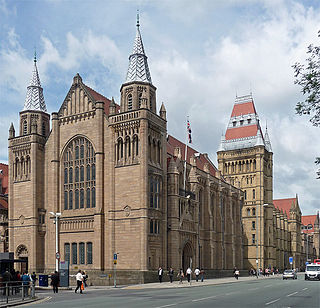
The Whitworth Building is a grade II* listed building on Oxford Road and Burlington Street in Chorlton-on-Medlock, Manchester, England. It has been listed since 18 December 1963 and is part of the University of Manchester. It lies at the south-east range of the old quadrangle of the University, with the Manchester Museum adjoined to the north, and the former Christie Library connected to the west.

Bridgewater House is a packing and shipping warehouse at 58–60 Whitworth Street, Manchester, England. It is recorded in the National Heritage List for England as a designated Grade II listed building.

Wythenshawe Bus Garage is a Grade II* listed building in Wythenshawe, Greater Manchester, England.
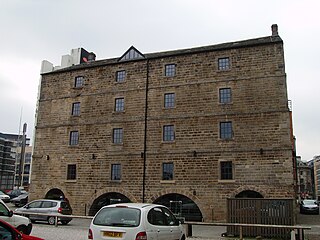
Dale Street Warehouse is an early 19th-century warehouse in the Piccadilly Basin area of Manchester city centre, England. It is a Grade II* listed building as of 10 November 1972. It is the earliest surviving canal warehouse in the city. The building is dated 1806 with the initials "WC" on the datestone, indicating that it was designed by William Crosley, an engineer who worked with William Jessop on the inner-Manchester canal system.

Asia House at No. 82 Princess Street, Manchester, England, is an early 20th century packing and shipping warehouse built between 1906 and 1909 in an Edwardian Baroque style. It is a Grade II* listed building as at 3 October 1974. Nikolaus Pevsner's The Buildings of England describes the warehouse, and its companion, No. 86, Manchester House, as "quite splendid ... good examples of the warehouse type designed for multiple occupation by shipping merchants". It attributes its design to I.R.E. Birkett, architect of the Grade II listed companion building, Manchester House, which is similar in design. English Heritage attributes it to Harry S. Fairhurst. Asia House has an "exceptionally rich" entrance hall and stairwell, "lined with veined marble and green and cream faience, with designs of trees and Art Nouveau stained glass".

Lancaster House in Whitworth Street, Manchester, England, is a former packing and shipping warehouse built between 1905 and 1910 for Lloyd's Packing Warehouses Limited, which had, by merger, become the dominant commercial packing company in early 20th century Manchester. It is in the favoured Edwardian Baroque style and constructed with a steel frame clad with granite at the base and Accrington red brick and orange terracotta. The back of the building is plain red brick. It is a Grade II* listed building as of 2 October 1974.
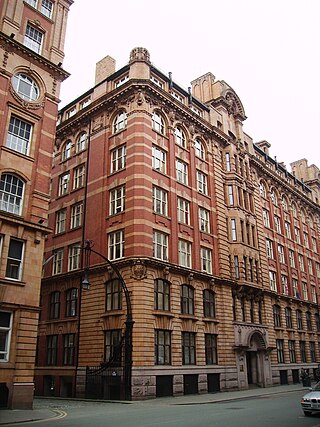
India House in Whitworth Street, Manchester, England, is a packing and shipping warehouse built in 1906 for Lloyd's Packing Warehouses Limited, which had, by merger, become the dominant commercial packing company in early-20th century Manchester. It is in the favoured Edwardian Baroque style and is steel-framed, with cladding of buff terracotta and red brick with buff terracotta dressings. It is a Grade II* listed building as of 2 October 1974.

38 and 42 Mosley Street in Manchester, England, is a double-block Victorian bank constructed between 1862 and c. 1880 for the Manchester and Salford Bank. It is located on the corner of Mosley Street and York Street.

The River Irwell Railway Bridge was built for the Liverpool & Manchester Railway (L&MR), the world's first passenger railway which used only steam locomotives and operated as a scheduled service, near Water Street in Manchester, England. The stone railway bridge, built in 1830 by George Stephenson, was part of Liverpool Road railway station. The bridge was designated a Grade I listed building on 19 June 1988.

Portland Street is a street in Manchester, England, which runs from Piccadilly at its junction with Newton Street south-westwards to Oxford Street at its junction with Chepstow Street. The major buildings of Portland Street include the largest former warehouse in the city centre, Watts Warehouse, the former Bank of England Building and other former warehouses on the corners of Princess Street.

The former Lancaster Carriage and Wagon Works is located in Caton Road, Lancaster, Lancashire, England. The works produced railway rolling stock and trams. The buildings were designed by the local architect E. G. Paley. After the company moved its business elsewhere, the building was used during the First World War for the internment of enemy aliens. It is listed at Grade II, and, as of 2011, is in use as an office, warehouse and factory.
In the final half of the 19th century Manchester's reputation as a financial and commercial centre was boosted by the unprecedented number of warehouses erected in the city centre. In 1806 there were just over 1,000 but by 1815 this had almost doubled to 1,819. Manchester was dubbed "warehouse city". The earliest were built around King Street although by 1850 warehouses had spread to Portland Street and later to Whitworth Street. They are direct descendants of the canal warehouses of Castlefield.

The Redfern Building is a Grade-II listed building which was completed in 1936 in Manchester, England. The building is situated on Dantzic Street and meets the junction of Mayes Street and Hanover Street. Redfern was originally built for office and warehouse use.
Manchester is a city in Northwest England. The M3 postcode area of the city includes the western part of the city centre. The area contains 79 listed buildings that are recorded in the National Heritage List for England. Of these, five are listed at Grade I, the highest of the three grades, two are at Grade II*, the middle grade, and the others are at Grade II, the lowest grade.
Manchester is a city in Northwest England. The M60 postcode area of the city is termed a non-geographic postcode area - that is, it does not correspond with a specific area. Buildings given an M60 postcode were historically very large receivers of mail, and were usually located in the city centre, although Great Universal Stores also used an M60 code. The postcode was created for internal Royal Mail reasons - it allowed for large amounts of mail to bypass the sorting processes within the city centre quickly and efficiently. The postcode contains 13 listed buildings that are recorded in the National Heritage List for England. Of these, one is listed at Grade I, the highest of the three grades, one is at Grade II*, the middle grade, and the others are at Grade II, the lowest grade. The area to the northwest contains HM Prison Manchester, and four structures associated with it are listed. The other listed buildings include two structures associated with Liverpool Road railway station, office buildings, a hotel, a department store, and a pair of bollards.























